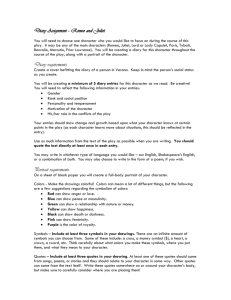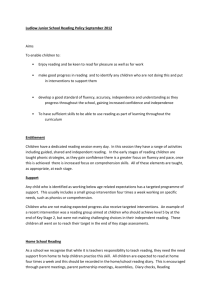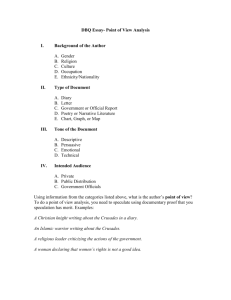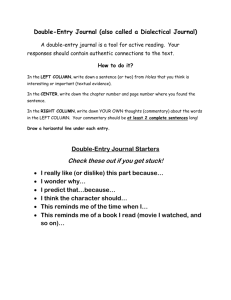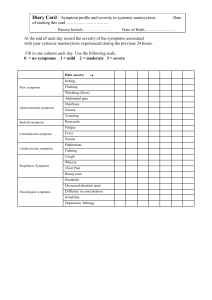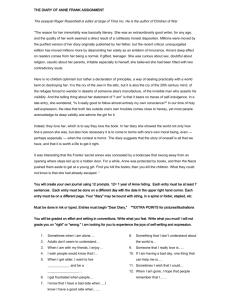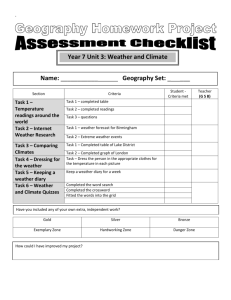Summer Reading Double-Entry Journal Assignment
advertisement
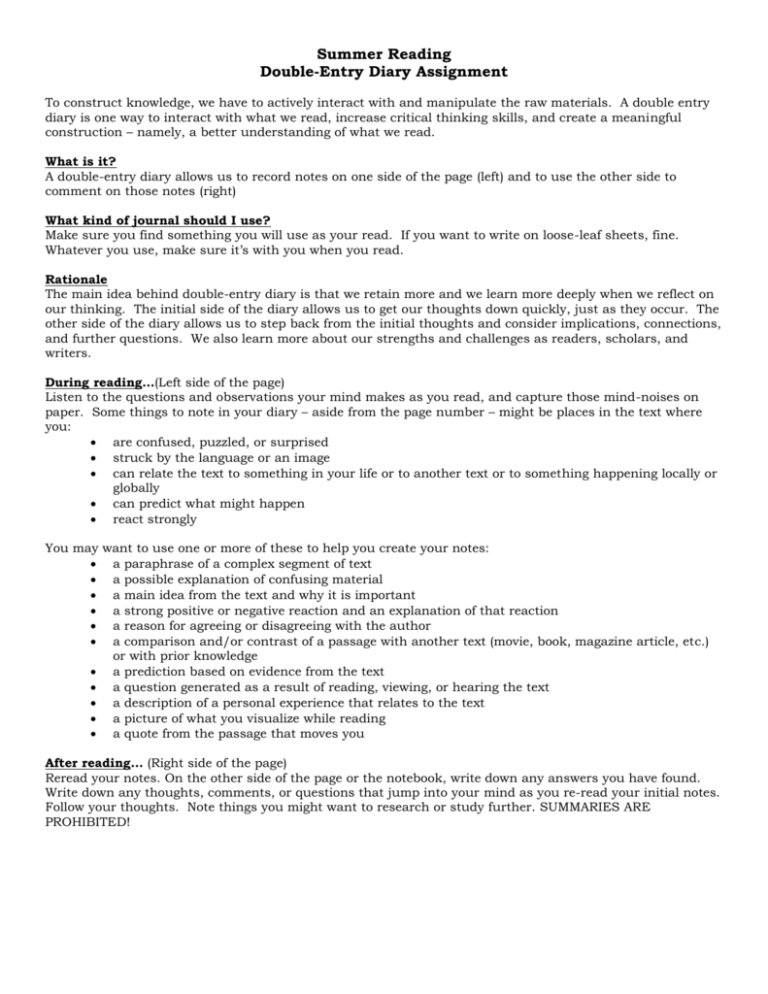
Summer Reading Double-Entry Diary Assignment To construct knowledge, we have to actively interact with and manipulate the raw materials. A double entry diary is one way to interact with what we read, increase critical thinking skills, and create a meaningful construction – namely, a better understanding of what we read. What is it? A double-entry diary allows us to record notes on one side of the page (left) and to use the other side to comment on those notes (right) What kind of journal should I use? Make sure you find something you will use as your read. If you want to write on loose-leaf sheets, fine. Whatever you use, make sure it’s with you when you read. Rationale The main idea behind double-entry diary is that we retain more and we learn more deeply when we reflect on our thinking. The initial side of the diary allows us to get our thoughts down quickly, just as they occur. The other side of the diary allows us to step back from the initial thoughts and consider implications, connections, and further questions. We also learn more about our strengths and challenges as readers, scholars, and writers. During reading…(Left side of the page) Listen to the questions and observations your mind makes as you read, and capture those mind-noises on paper. Some things to note in your diary – aside from the page number – might be places in the text where you: are confused, puzzled, or surprised struck by the language or an image can relate the text to something in your life or to another text or to something happening locally or globally can predict what might happen react strongly You may want to use one or more of these to help you create your notes: a paraphrase of a complex segment of text a possible explanation of confusing material a main idea from the text and why it is important a strong positive or negative reaction and an explanation of that reaction a reason for agreeing or disagreeing with the author a comparison and/or contrast of a passage with another text (movie, book, magazine article, etc.) or with prior knowledge a prediction based on evidence from the text a question generated as a result of reading, viewing, or hearing the text a description of a personal experience that relates to the text a picture of what you visualize while reading a quote from the passage that moves you After reading… (Right side of the page) Reread your notes. On the other side of the page or the notebook, write down any answers you have found. Write down any thoughts, comments, or questions that jump into your mind as you re-read your initial notes. Follow your thoughts. Note things you might want to research or study further. SUMMARIES ARE PROHIBITED! Different Ways to Format your Journal During Reading Notes & Passages from the Text… (Left Hand Side) Page # After Reading Notes, Comments, Responses, & Reflections… (Right Hand Side) Quotes from the text Visual commentary (drawings, visual analogies, doodles) Quotes from the text Written reactions, reflections, commentary, musings (“Hmmm…”) Quotes from the text Connections Text to text (Ex. This reminds me of another book I have read…) Text to Self ( Ex. This reminds me of the time when my mom and I…) Text to world (Ex. This reminds me of the recent news story I read about…) Observations, details revealed by close reading Significance to the text What the text says… Why you think the text says this… Questions: “I wonder why…” Possible answers: “Maybe it is because…” Quotes from texts Questions (Clarifying & Probing): “I am confused about…” Quotes from texts Social Questions (Race, class, gender inequalities) Quotes from texts Thinking Prompts: This reminds me of… I remember a time when… I predict… I think this means… I wonder... Quotes from texts Naming Literary or Persuasive (Rhetorical) Techniques Please Note: You DO NOT have to follow the pattern of journaling above. These are merely suggestions to help move you along through the process. By the time you finish reading your book, you have at least 20 entries in your diary that address the entire book, so pace yourself. Also the entries on the left side of the page should take up to ½ to ¾ of a page for each entry. These DEDs will be due on the first day of school, and they will comprise a significant portion of your first term grade. So remember to question, predict, clarify, connect and evaluate as you read.


